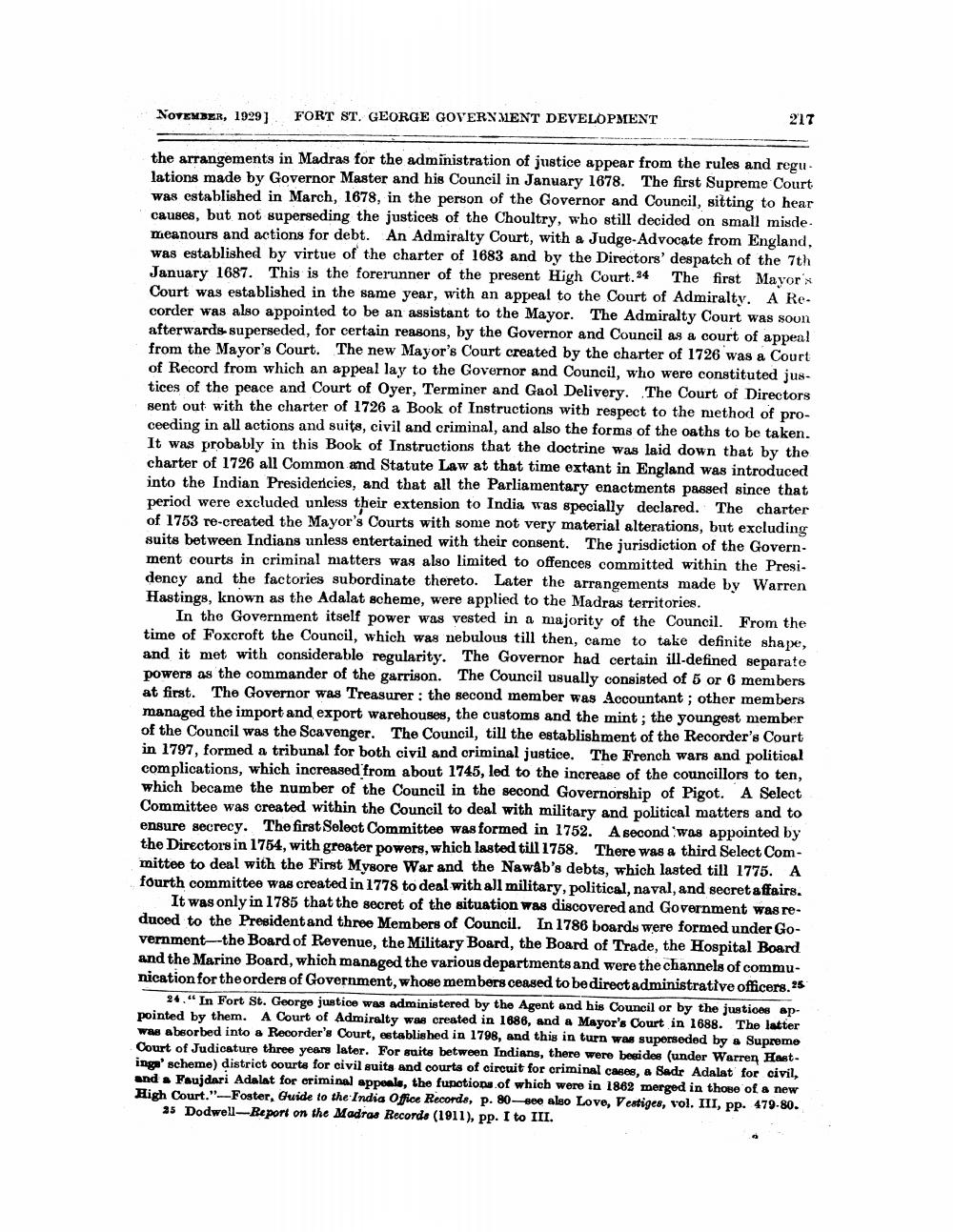________________
NOVEMBER, 1929)
FORT ST. GEORGE GOVERXMENT DEVELOPMENT
217
the arrangements in Madras for the administration of justice appear from the rules and regulations made by Governor Master and his Council in January 1678. The first Supreme Court was established in March, 1678, in the person of the Governor and Council, sitting to hear causes, but not superseding the justices of the Choultry, who still decided on small misde. meanours and actions for debt. An Admiralty Court, with a Judge-Advocate from England, was established by virtue of the charter of 1683 and by the Directors' despatch of the 7th January 1687. This is the forerunner of the present High Court.24 The first Mavor Court was established in the same year, with an appeal to the Court of Admiralty. A Re. corder was also appointed to be an assistant to the Mayor. The Admiralty Court was soon afterwards superseded, for certain reasons, by the Governor and Council as a court of appeal from the Mayor's Court. The new Mayor's Court created by the charter of 1726 was a Court of Record from which an appeal lay to the Governor and Council, who were constituted justices of the peace and Court of Oyer, Terminer and Gaol Delivery. The Court of Directors sent out with the charter of 1726 a Book of Instructions with respect to the method of proceeding in all actions and suite, civil and criminal, and also the forms of the oaths to be taken. It was probably in this Book of Instructions that the doctrine was laid down that by the charter of 1726 all Common and Statute Law at that time extant in England was introduced into the Indian Presidencies, and that all the Parliamentary enactments passed since that period were excluded unless their extension to India was specially declared. The charter of 1753 re-created the Mayor's Courts with some not very material alterations, but excluding suits between Indians unless entertained with their consent. The jurisdiction of the Government courts in criminal matters was also limited to offences committed within the Presi. dency and the factories subordinate thereto. Later the arrangements made by Warren Hastings, known as the Adalat scheme, were applied to the Madras territories.
In the Government itself power was vested in a majority of the Council. From the time of Foxcroft the Council, which was nebulous till then, came to take definite shape, and it met with considerable regularity. The Governor had certain ill-defined separate powers as the commander of the garrison. The Council usually consisted of 5 or 6 members at first. The Governor was Treasurer : the second member was Accountant; other members managed the import and export warehouses, the customs and the mint, the youngest member of the Council was the Scavenger. The Council, till the establishment of the Recorder's Court in 1797, formed a tribunal for both civil and criminal justice. The French wars and political complications, which increased from about 1745, led to the increase of the councillors to ten, which became the number of the Council in the second Governorship of Pigot. A Select Committee was created within the Council to deal with military and political matters and to ensure secrecy. The first Select Committee was formed in 1752. A second was appointed by the Directors in 1764, with greater powers, which lasted till 1758. There was a third Select Committee to deal with the First Mysore War and the Nawab's debts, which lasted till 1775. A fourth committee was created in 1778 to deal with all military, political, naval, and secret affairs.
It was only in 1785 that the secret of the situation was discovered and Government was reduced to the President and three Members of Council. In 1786 boards were formed under Government--the Board of Revenue, the Military Board, the Board of Trade, the Hospital Board and the Marine Board, which managed the various departments and were the channels of communication for the orders of Government, whose members ceased to be direct administrative officers.25
24." In Fort St. George justice was administered by the Agent and his Council or by the justices appointed by them. A Court of Admiralty was created in 1886, and a Mayor's Court in 1688. The latter was absorbed into a Recorder's Court, established in 1798, and this in turn was superseded by a Supreme Court of Judicature three years later. For suits between Indians, there were besides (under Warren Hast. ing scheme) district oourts for civil suits and courts of circuit for criminal cases, a Sadr Adalat for civil, and a Faujdari Adalat for criminal appeals, the functions of which were in 1862 merged in those of a new High Court."-Foster, Guide to the India Office Records, p. 80-100 also Love, Vestiges, vol. III, pp. 479-80.
35 Dodwell-Report on the Madras Records (1911), pp. I to III.




